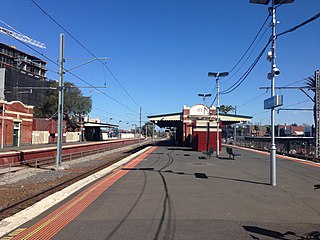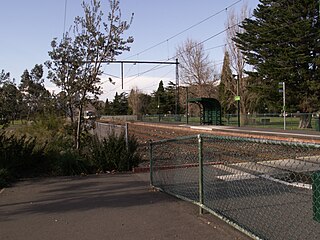
Essendon railway station is a commuter railway station on the Craigieburn line, which is part of the Melbourne railway network. It serves the northern suburb of Essendon, in Melbourne, Victoria, Australia. Essendon station is a ground level premium station, featuring three platforms, an island platform with two faces and one side platform. It opened on 1 November 1860, with the current station provided in 1871. It initially closed on 1 July 1864, then reopened on 9 October 1871.

Broadmeadows railway station is located on the North East line in Victoria, Australia. It serves the northern Melbourne suburb of Broadmeadows, and opened on 1 February 1873.

Seymour is a town located in the Southern end of the Goulburn Valley in the Shire of Mitchell, Victoria, Australia and is located 104 kilometres (65 mi) north of Melbourne. At the 2021 census, Seymour had a population of 6,569. The township services the surrounding agricultural industries as well as the nearby military base of Puckapunyal, which is an important training centre for the Australian Army. Other important sectors of employment in Seymour include retail, light engineering, agricultural services support, medical services, and education.

The Goulburn Valley is a sub-region, part of the Hume region of the Australian state of Victoria. The sub-region consists of those areas in the catchment of the Goulburn River and other nearby streams, and is part of the Murray-Darling Basin. The Goulburn Valley is bordered on the south by the Great Dividing Range and to the north by the Murray River, the state border with New South Wales. The sub-region is one of Australia's most productive and intensively farmed areas and is predominantly irrigated.

Hamilton railway station is a heritage-listed railway station on the Newcastle line in the inner Newcastle suburb of Hamilton in New South Wales, Australia. It was added to the New South Wales State Heritage Register on 2 April 1999.

Graham Street is light rail station and former railway station on the former Port Melbourne railway line, in the inner Melbourne suburb of Port Melbourne, Victoria, Australia. Located to the north of Graham Street, between Evans Street and Station Street, the station has been demolished since 1987, and is now served by route 109 trams, stopping at a pair of low level platforms.

Donnybrook railway station is a regional railway station on the North East line, which is part of the Regional railway network. It serves the northern suburb of Donnybrook, in Melbourne, Victoria, Australia. Donnybrook station is a ground level unstaffed station, featuring two side platforms. It opened on 14 October 1872, with the current station provided in 2020.

Ashwellthorpe was a railway station that existed in the village of Ashwellthorpe, Norfolk, on a cutoff line between Forncett and Wymondham. This entry covers the history of the line and the station.
Kilmore East railway station is located on the North East line in Victoria, Australia. It serves the town of Kilmore East, and opened on 18 April 1872 as Kilmore. It was renamed Kilmore East on 1 October 1888.

Broadford railway station is located on the North East line in Victoria, Australia. It serves the town of Broadford, and opened on 18 April 1872.

Tallarook railway station is located on the North East line in Victoria, Australia. It serves the town of Tallarook, and it opened on 18 April 1872.

Seymour railway station is on the North East line in Victoria, Australia. It serves the town of Seymour, and opened on 20 November 1872. The station is the terminus for V/Line's Seymour line services.

Benalla railway station is located on the North East line in Victoria, Australia. It serves the town of Benalla, and it opened on 18 August 1873.
The North East railway line is a railway line in Victoria, Australia. The line runs from Southern Cross railway station on the western edge of the Melbourne central business district to Albury railway station in the border settlement of Albury-Wodonga, serving the cities of Wangaratta and Seymour, and smaller towns in northeastern Victoria.

Exmouth Junction is the railway junction where the Exmouth branch line diverges from the London Waterloo to Exeter main line in Exeter, Devon, England. It was for many years the location for one of the largest engine sheds in the former London and South Western Railway. The sidings served the railway's concrete casting factory as well as a goods yard.

Toolamba is a closed railway station on the Goulburn Valley railway in the town of Toolamba, Victoria, Australia. The station opened as a junction at the same time as the railway from Mangalore to Shepparton on 13 January 1880, with the line to Tatura opening on the same day. The last passenger service to the station from Echuca ran on 2 March 1981 with Y class diesel locomotive Y161 an ABE carriage and a C van. This consist had only been introduced a few months prior, with a DERM usually being rostered. Toolamba finally closed as a station on 20 December 1987.
There are seventeen disused railway stations on the Cornish Main Line between Plymouth in Devon and Penzance in Cornwall, England. The remains of nine of these can be seen from passing trains. While a number of these were closed following the so-called "Beeching Axe" in the 1960s, many of them had been closed much earlier, the traffic for which they had been built failing to materialise.

Rothley railway station is a heritage railway station on the preserved section of the Great Central Railway's London Extension. Built to the standard island platform pattern of country stations on the line, it originally opened on 15 March 1899 and has been restored to late Edwardian era condition, circa 1910.
There are eight disused railway stations between Wadebridge and Bodmin North on the former Bodmin and Wadebridge Railway in Cornwall, in the United Kingdom, with ten other closed sidings on the branches to Ruthern Bridge and Wenfordbridge. The section from Boscarne Junction to Bodmin General is currently part of the Bodmin and Wenford Steam Railway; the line from Wadebridge to Wenfordbridge is now part of the Camel Trail, and the line to Ruthern Bridge can be followed for much of its length as it runs parallel to a public road.

Copmanthorpe railway station served the village of Copmanthorpe, North Yorkshire, England from 1839 to 1959 on the York to Normanton line. The line also became part of the East Coast Main Line at various periods. The station was moved and substantially rebuilt halfway through its working life.
















